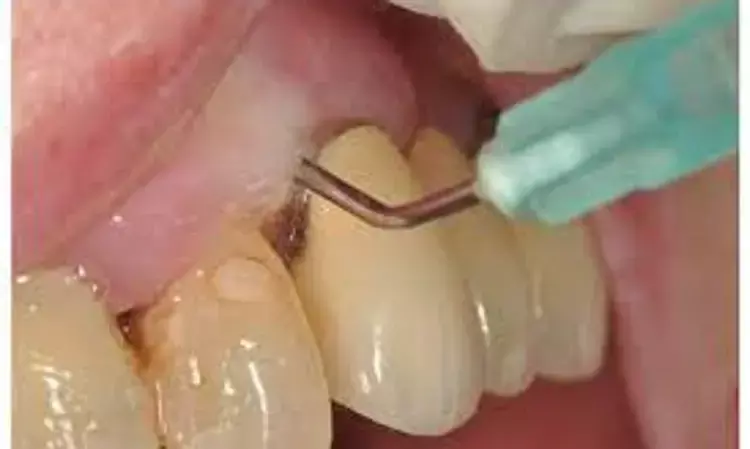- Home
- Medical news & Guidelines
- Anesthesiology
- Cardiology and CTVS
- Critical Care
- Dentistry
- Dermatology
- Diabetes and Endocrinology
- ENT
- Gastroenterology
- Medicine
- Nephrology
- Neurology
- Obstretics-Gynaecology
- Oncology
- Ophthalmology
- Orthopaedics
- Pediatrics-Neonatology
- Psychiatry
- Pulmonology
- Radiology
- Surgery
- Urology
- Laboratory Medicine
- Diet
- Nursing
- Paramedical
- Physiotherapy
- Health news
- Fact Check
- Bone Health Fact Check
- Brain Health Fact Check
- Cancer Related Fact Check
- Child Care Fact Check
- Dental and oral health fact check
- Diabetes and metabolic health fact check
- Diet and Nutrition Fact Check
- Eye and ENT Care Fact Check
- Fitness fact check
- Gut health fact check
- Heart health fact check
- Kidney health fact check
- Medical education fact check
- Men's health fact check
- Respiratory fact check
- Skin and hair care fact check
- Vaccine and Immunization fact check
- Women's health fact check
- AYUSH
- State News
- Andaman and Nicobar Islands
- Andhra Pradesh
- Arunachal Pradesh
- Assam
- Bihar
- Chandigarh
- Chattisgarh
- Dadra and Nagar Haveli
- Daman and Diu
- Delhi
- Goa
- Gujarat
- Haryana
- Himachal Pradesh
- Jammu & Kashmir
- Jharkhand
- Karnataka
- Kerala
- Ladakh
- Lakshadweep
- Madhya Pradesh
- Maharashtra
- Manipur
- Meghalaya
- Mizoram
- Nagaland
- Odisha
- Puducherry
- Punjab
- Rajasthan
- Sikkim
- Tamil Nadu
- Telangana
- Tripura
- Uttar Pradesh
- Uttrakhand
- West Bengal
- Medical Education
- Industry
Nonsurgical mechanical debridement with adjunctive ozone gels and chlorhexidine effective in periodontal treatment

Nonsurgical mechanical debridement with adjunctive ozone gels and chlorhexidine is effective in periodontal treatment suggests a new study published in the Oral Diseases.
Periodontal disease is one of the most prevalent diseases, with 1.1 billion prevalent cases worldwide and the 40–49 age group being the most affected. The major etiological factor is the dental biofilm, a structured organization of microorganisms attached to dental hard tissues and immersed in the extracellular matrix. Smoking and diabetes are recognized risk factors, while occlusal trauma, open interproximal contacts, overhanging/over contoured restorations, mucogingival deformities, and anatomical variations are considered contributing factors. A study was done to evaluate the efficacy of newly introduced ozonated gels compared with conventional chlorhexidine gel in the home management of periodontal patients. 30 patients with bilateral periodontal disease (severity I, complexity II) were enrolled (split-mouth study design). After non-surgical mechanical periodontal debridement, the teeth were randomly divided into two groups: teeth in the Control group were treated with a chlorhexidine-based gel to aid oral hygiene manoeuvres for 2 weeks after the first visit, while teeth in the Test group were treated in the same way with ozone-based gels. After the baseline assessment, the follow-up included assessments at 1, 2, and 6 months. The variables evaluated were clinical attachment loss (CAL), probing pocket depth (PPD), bleeding on probing (BoP), plaque control record (PCR), recession (R), and tooth mobility (TM). Results: For clinical attachment loss, probing pocket depth, BoP, and PCR, significant intragroup differences were found for both groups (p < 0.05), in contrast to intergroup differences (p > 0.05). No significant differences were found for R and TM. Nonsurgical mechanical periodontal debridement with adjunctive use of ozone and chlorhexidine was found to be effective in periodontal treatment. Ozone could be suggested as an alternative to chlorhexidine.
Reference:
Scribante, A., Gallo, S., Pascadopoli, M., Frani, M., & Butera, A. (2023). Ozonized gels vs chlorhexidine in non-surgical periodontal treatment: A randomized clinical trial. Oral Diseases, 00, 1–8. https://doi.org/10.1111/odi.14829
Keywords:
Nonsurgical mechanical debridement, ozone gels, chlorhexidine periodontal treatment, Scribante, A., Gallo, S., Pascadopoli, M., Frani, M., & Butera, A
Dr. Shravani Dali has completed her BDS from Pravara institute of medical sciences, loni. Following which she extensively worked in the healthcare sector for 2+ years. She has been actively involved in writing blogs in field of health and wellness. Currently she is pursuing her Masters of public health-health administration from Tata institute of social sciences. She can be contacted at editorial@medicaldialogues.in.
Dr Kamal Kant Kohli-MBBS, DTCD- a chest specialist with more than 30 years of practice and a flair for writing clinical articles, Dr Kamal Kant Kohli joined Medical Dialogues as a Chief Editor of Medical News. Besides writing articles, as an editor, he proofreads and verifies all the medical content published on Medical Dialogues including those coming from journals, studies,medical conferences,guidelines etc. Email: drkohli@medicaldialogues.in. Contact no. 011-43720751


